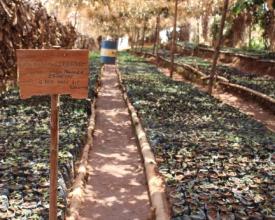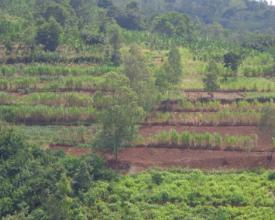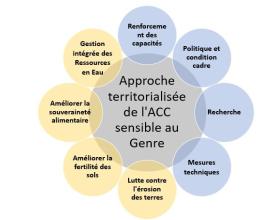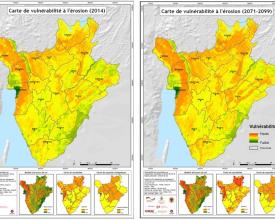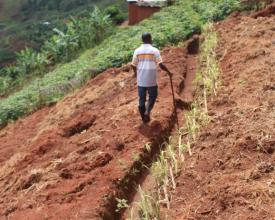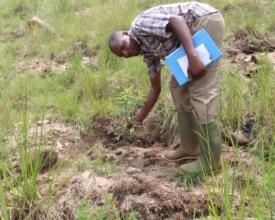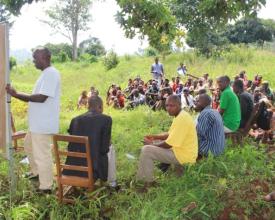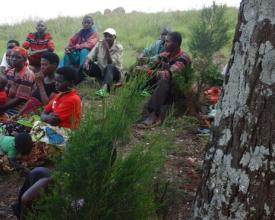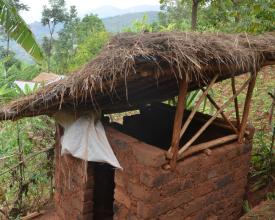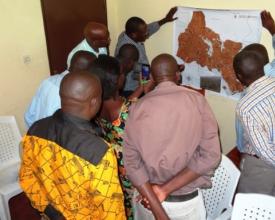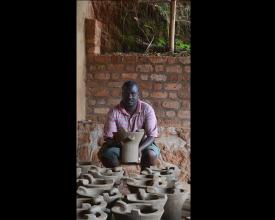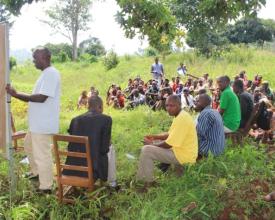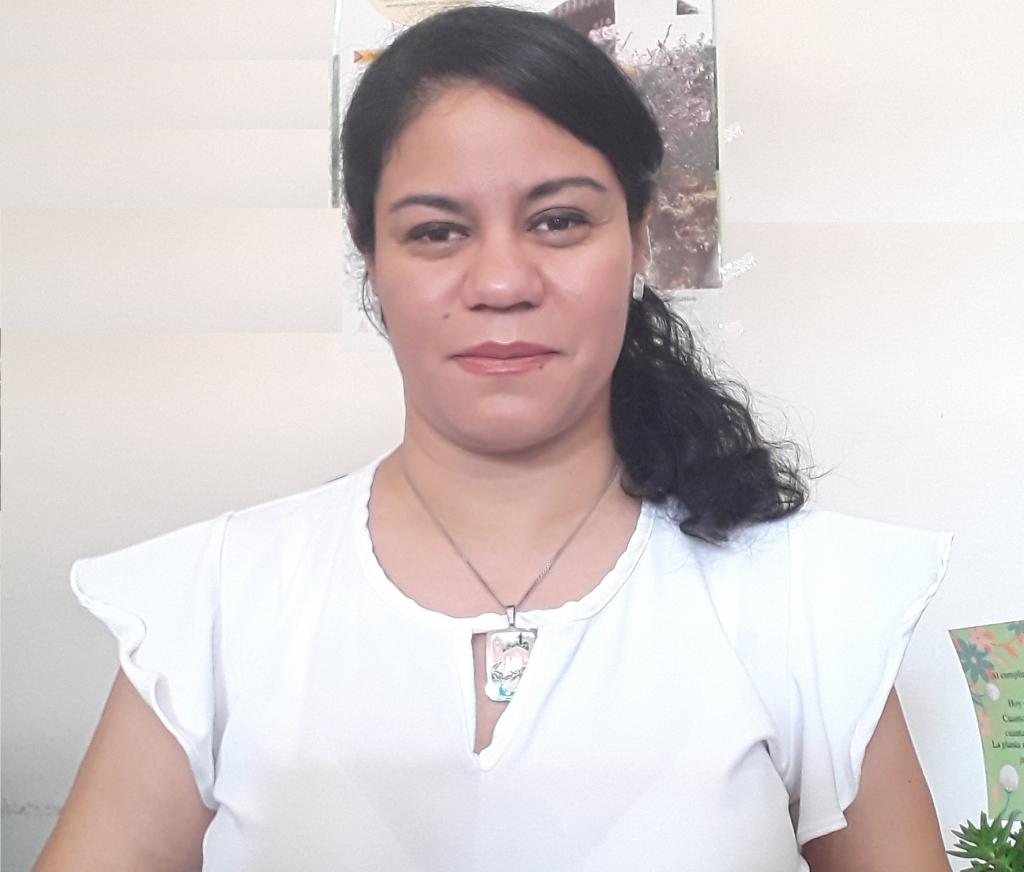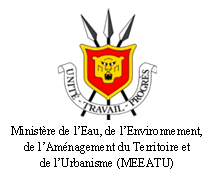
Resilient management of water and soil resources in Burundi
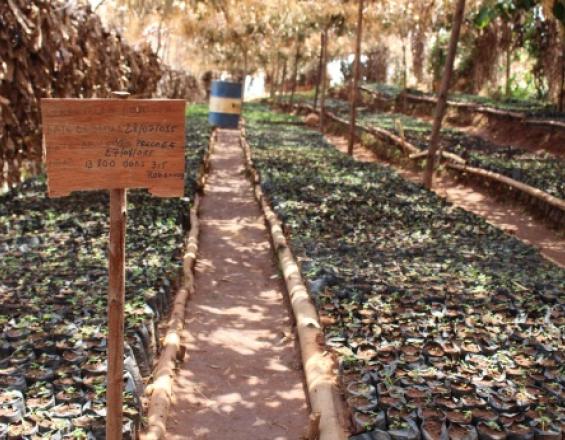
The GIZ project ACCES implements adaptation measures in vulnerable watersheds. Natural resources, such as water and soil, are managed sustainably in order to reduce erosion and improve agricultural yields. "green" no-regret adaptation measures, such as agroforestry and community reforestation, are complemented by other measures such as rainwater storage and promotion of rainwater infiltration and soil conservation measures.
Context
Challenges addressed
Burundi's population, heavily dependent on agriculture and natural resources, is poverty-stricken and experiences food shortages and recurrent famines. The degradation of ecosystems and water and soil resources are due, among other things, to the heavy pressure on land resources, inadequate exploitation of natural resources and overexploitation of forest resources. These problems are further aggravated by climate change:
- Increased rainfall in the eastern and southern regions of the country and the central plateau
- Dryer months preceding the rain season
- Potential extension of the dry season
- High probability of an average annual increase in air temperatures during the 21st century, especially during the dry season
- Increased risk of extreme events (floods, landslides, etc.).
Location
Process
Summary of the process
The building blocks interact according to a holistic approach based on the implementation of no-regret CCA activities / measures derived from a "bottom-down" and "top-down" analysis. These measures are reliable and easily replicable because they are adapted to the local context and shared with the population. The following diagram represents the territorialized and gender-sensitive CCA approach of the project, which is based on several pillars (holistic design): Integrated Water Resource Management (IWRM), improved soil fertility, Food sovereignty and fight against soil erosion. To achieve this, the project uses several types of CCA measures: capacity building, policy and framework condition interventions, green technical measures and action research.
Building Blocks
Integrated vulnerability analysis at national and local level
The vulnerability assessment was carried out for three periods: the status quo in 2014, the period 2030-2060 and the period 2070-2100. The assessment follows the eight-step approach described in GIZ’s Vulnerability Sourcebook, and was supplemented by a scientific modeling of the impacts of climate change for Burundi.
The study was carried out by three institutions (Adelphi, EURAC, PIK) in collaboration with GIZ / ACCES and its partners. Four national workshops were held with all relevant stakeholders. A group of experts was created to advise and direct the process. Activities at the local level at the selected project sites were carried out in close collaboration with local governmental and non-governmental actors and the local population.
The results of the assessment were presented in the form of vulnerability maps for the three factors of erosion, drought and malaria prevalence. Highly vulnerable areas have been identified to guide the identification of three pilot watersheds. In these watersheds, local vulnerability assessments were conducted to identify local challenges and appropriate adaptation measures.
Enabling factors
- National Workshops: enabled participants (government and civil society) to better understand the process and to share their perspectives and expertise on the topic.
- Establishment of an expert group composed of experts from various Burundian ministries and institutions: important for the ownership of the process itself and its results.
- Integration of vulnerability assessment into the National Adaptation Plan (NAP) process in Burundi.
Lesson learned
- Data availability was a major challenge. Most government records are not classified and documents and information are incomplete. Aggregate data are often only available at the national and provincial levels, making it difficult to communicate at the local level.
- The results of the vulnerability assessment form the basis for integrating climate change adaptation into national and local investment policies, strategies and plans. Other actors can use this experience and information for adaptation planning.
- The methodology used to assess vulnerability in Burundi is based on a standardized methodology, which allows for replication.
Resources
Holistic and participatory approach to CC adaptation
The ACCES project developed a holistic and participatory approach through the implementation of adaptation measures in the 3 pilot zones. This approach takes into account the environmental, societal, economic and pedoclimatic dimensions of Burundi.
The successive stages of implementation have consisted of establishing a list of adaptation measures that can respond to climatic stimuli. These measures have been categorized according to their typology: grey measures, green measures, capacity building, action research, policy framework. The project prioritized capacity building measures and green measures for feasibility and sustainability issues. The project then conducted participatory planning workshops in each of the pilot areas to assess their acceptability in consultation with the population. The result was a set of consensual and specific CCA measures for each of the zones. To ensure quality and sustainability, a follow-up technical committee was established locally (CTS-L). This committee is made up of people from the local administration, farmers leaders, association leaders, who are in charge of monitoring and sustaining the measures.
Enabling factors
- Capacity building of actors on all levels on CC and CCA
- Good knowledge of the agricultural practices of the intervention zones (close collaboration with INADES-Formation Burundi)
- Participatory planning of CCA measures with the local population to ensure good acceptability
- Establishment and training of a Local Monitoring Technical Committee, a group representing the interests of the population in order to ensure the quality and sustainability of CCA measures.
Lesson learned
In order to ensure the sustainability of CCA measures, it is imperative to ensure public support (through participatory planning), understanding (training, awareness-raising, capacity building) and accountability (Technical committee).
The holistic approach to adaptation measures has been based on a cross-cutting approach to environmental issues in Burundi, also drawing on the expertise of other GIZ projects (ProSecEau and EnDev Programs).
Innovative measures were first tested on a small scale to assess their impacts. Once validated, these measures could be duplicated in the other intervention areas of the project.
Adaptation, gender and the empowerment of women: an integrated approach
In Burundi, gender inequalities continue to restrict women's access to decision-making, resources and benefits (education, information, land ownership, time, jobs, credits, etc.) and the equitable distribution of tasks. Faced with this situation, women are becoming more vulnerable but are also excluded from efforts to mitigate and adapt to the effects of climate change.
The ACCES project carried out a gender analysis in its intervention zones. The evaluation of the status of gender mainstreaming in planning and implementation of adaptation measures, in information and early warning systems and in Community Development Community Plans (PCDCs) yielded several recommendations. One recommendation was the CCA model household approach. The goal is that couples are trained in replicating the techniques, skills and experiences gained through the project within their respective CCA households, taking into account that women are powerful change agents and development and in order to empower women.
Enabling factors
- Human resources trained on gender and knowledgeable of Burundian culture and traditions (eg gender focal points)
- Gender analysis as a basis for mainstreaming gender, carried out at all levels and in all fields of intervention.
- Capacity building of the members of the communal gender platforms and its integration in risk analysis and assessment as well as in the information and early warning systems.
Lesson learned
- Training and sensitization of model households (training of awareness-raising agents) is an essential prerequisite for changing mores and attitudes.
- Showing by example is probably the most appropriate method for initiating a change in men's perception of the role and responsibilities of women at the household and community level in general.
- Producing a booklet as a training guide for model households helps capitalize lessons learned and is a product that will serve as a vehicle for future scaling up.
- Focus on qualitative and not just quantitative aspects in order to grasp the social and cultural mechanisms that impede the empowerment of women is key (not only the number of women involved in activities is important but the processes of change within the household or community).
Innovative adaptation measures to climate change
Climate change adaptation measures are initiatives and actions taken to prevent or reduce damage, or exploit beneficial opportunities from the effects of climate change. The ACCES project promoted innovative adaptation measures in consultation with the population:
- Adapted crops to climate change: the use of crop seeds adapted to drought or heavy rainfall, helps to strengthen the resilience of populations.
- Risk Management and Disaster Prevention: In order to reduce the vulnerability of the Burundian population to extreme weather events, the establishment of an information system that allows the population to access weather forecasts and early warning system in the event of extreme weather events.
- Akasuga toilets: The ecological latrine called AKASUGA allows the separate recovery of solid and liquid human excreta in order to improve soil fertility.
- Improved wood burning stoves: the spread and use of improved stoves contributes to reduce deforestation and the degradation of wood resources
- Seasonal forecasts: the diffusion of the seasonal forecast is a determining factor decisions for the agri-breeder
Enabling factors
• Participatory planning and accompaniment of CCA measures with the population and the local administration for good acceptance
• Gender mainstreaming in all CCA activities so that women play a leading role in the implementation of these measures
• Awareness-raising, training and capacity building enabled the various actors and beneficiaries to learn about the new CCA measures
.
Lesson learned
• Do not give up on cultural taboos or fears but listen to, understand and explain to the population the advantages of such measure (case of Akasuga latrine) which is now very popular after having encountered the reluctance of the population and the municipal administration
Impacts
The topic of ecosystem-based adaptation found its way into debates in Burundi. Facts about the relationship between the effects of climate change, environmental degradation and disaster prevention are becoming increasingly known and influence planning processes and action at national and local levels.
Through the planning and participatory implementation of adaptation measures, local actors are sensitized on the benefits of climate-sensitive management of water and soil resources. The population is increasingly aware of the value of "green" adaptation measures to improve their economic situation.
Beneficiaries
the Ministry of the Environment and the Ministry of Agriculture and Livestock
the NGOs
the local population of the pilot areas
